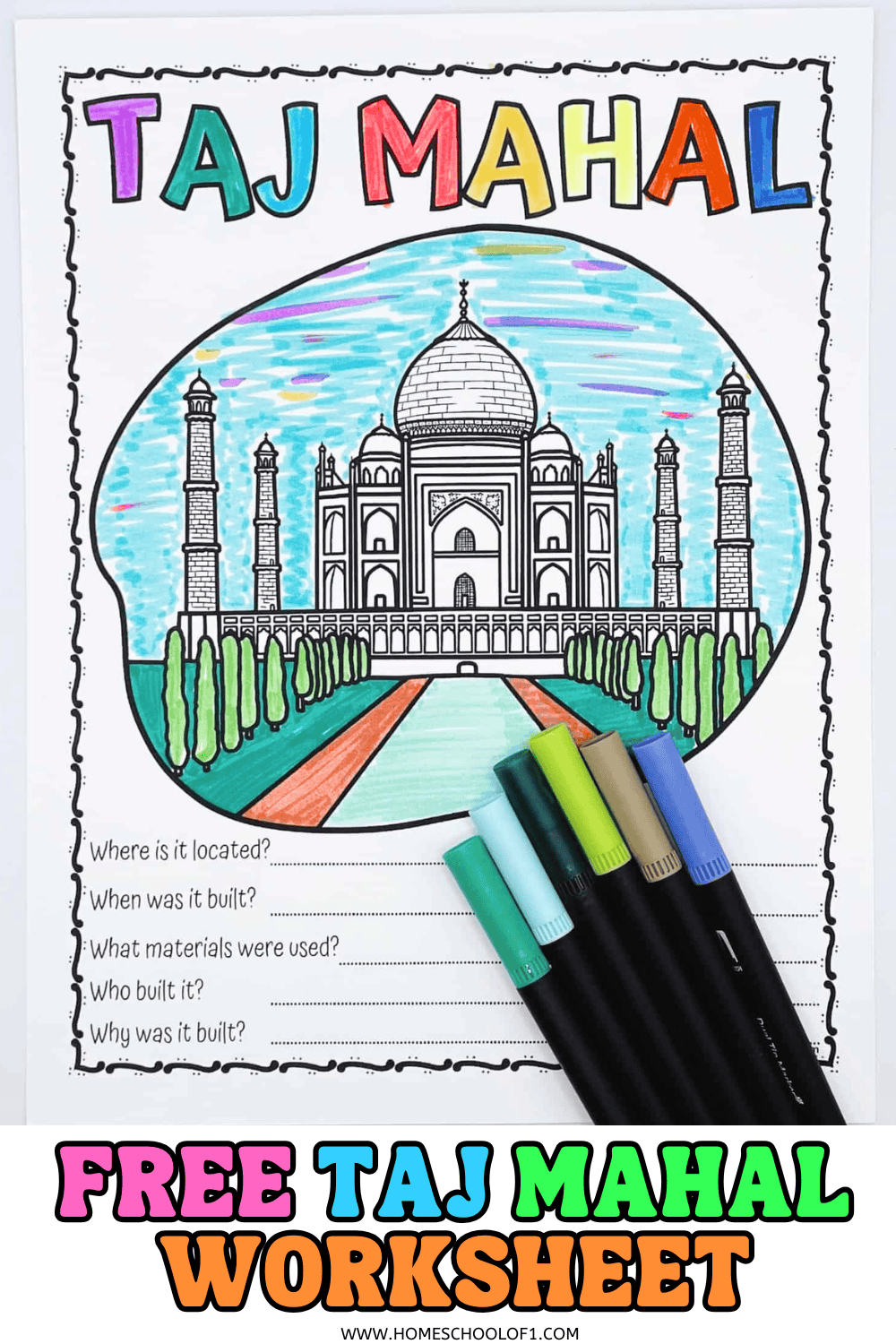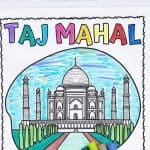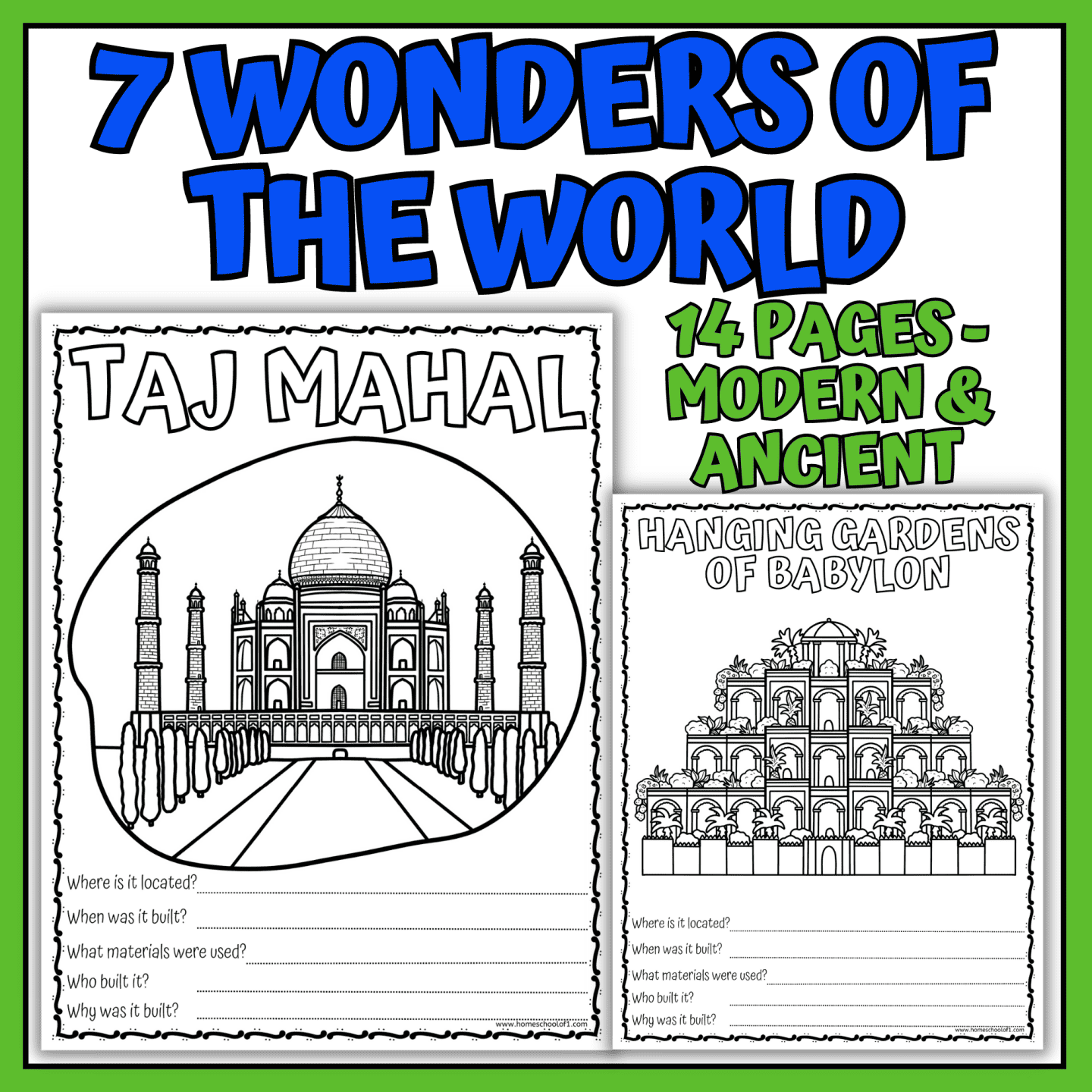Free Printable Taj Mahal Worksheet for Kids
This Taj Mahal worksheet turned a quick activity into one of our favorite lessons on famous world landmarks.
As we worked through the questions, we ended up diving into Indian history, Mughal architecture, and the story behind this incredible symbol of love.
This free world geography worksheet blends research, cultural facts, and a bit of art, making it easy to bring global learning to life at home or in the classroom.

**This post may contain affiliate links. As an Amazon Associate and a participant in other affiliate programs, I earn a commission on qualifying purchases.**
Taj Mahal Research
This Taj Mahal worksheet features a black and white illustration to color and a short set of questions to help kids explore one of the world’s most iconic landmarks.
They’ll learn where the Taj Mahal is, when it was built, who built it, and why—making this a simple yet meaningful way to connect art, geography, and history.
Where is the Taj Mahal located?
The Taj Mahal is in Agra, a city in the Indian state of Uttar Pradesh, India. It sits along the Yamuna River, which adds to its peaceful and scenic setting.

When was the Taj Mahal built?
Construction of the Taj Mahal began in 1632 and took around 22 years, finishing in 1653. The monument stands as a major achievement of Mughal architecture.
What materials were used in making the Taj Mahal?
The main structure is made of white marble from Rajasthan. It’s also decorated with intricate inlay work using precious and semi-precious stones like jasper, jade, crystal, and turquoise.
Who built the Taj Mahal?
Mughal Emperor Shah Jahan commissioned the Taj Mahal as a mausoleum for his wife, Mumtaz Mahal. Thousands of artisans, architects, and laborers helped bring the design to life.

Why was the Taj Mahal built?
It was built to honor Mumtaz Mahal, who died during childbirth. The Taj Mahal stands as a lasting symbol of devotion and is now recognized as a UNESCO World Heritage Site, visited by millions from around the world each year.
Interesting Facts About the Taj Mahal
- The Taj Mahal was built as a symbol of love by Emperor Shah Jahan for his wife, Mumtaz Mahal. It’s often called one of the greatest expressions of love in the world.
- This architectural masterpiece blends Persian, Islamic, and Indian styles. Over 20,000 workers helped complete its construction.
- The marble changes color throughout the day—from a soft pink in the morning, to bright white in the afternoon, to a golden glow at sunset.
- The Taj Mahal is decorated with gemstones like jasper, jade, turquoise, and lapis lazuli, used to create detailed floral and geometric patterns.
- A large reflecting pool, called the Charbagh, sits in front of the monument and mirrors the building beautifully when filled with water.
- Verses from the Quran are carved into the marble walls in intricate calligraphy, adding both spiritual and artistic depth.
- Beneath the structure is a hidden chamber, accessible through a lesser-known passage.
- The four minarets surrounding the Taj Mahal are slightly tilted outward to protect the main dome in case of an earthquake.
- Although it appears the same size from every angle, the Taj Mahal was designed with subtle proportions to create an optical illusion—it actually looks larger the farther you stand.
- It is a UNESCO World Heritage Site and is recognized as one of the New Seven Wonders of the World.
Explore more with our free continent of Asia worksheets—perfect for expanding your geography lessons.
Books About the Taj Mahal
If your kids are curious to learn more after working on the worksheet, these children’s books about the Taj Mahal offer a fun and educational way to dive deeper:
- Where is the Taj Mahal? Part of the popular “Where Is?” series, this book introduces kids to the monument’s history, design, and myths. It includes helpful extras like maps and timelines to support social studies lessons.
- The Mystery of the Taj Mahal. A great pick for kids who enjoy adventure, this story blends mystery with real-world learning. Young explorers uncover secrets and solve puzzles as they journey through one of the world’s most iconic landmarks.
- Let’s Visit Delhi & Taj Mahal! Told through the eyes of Maya and Neel, this interactive book gives readers a playful introduction to Indian culture, traditions, and historic sites. The illustrations and storytelling make it easy for kids to stay engaged.
- Good night Taj Mahal. This bedtime book offers a quiet and calming tour of the Taj Mahal, with soft imagery and gentle text. It’s a lovely way to wind down while appreciating the beauty and architecture of this world wonder.
Get the Free Taj Mahal Research Worksheet Pdf Here!
Want more? Check out our full set of Wonders of the World worksheets, featuring all 14 ancient and modern wonders—available as a printable bundle for easy learning at home or in the classroom.
Ready to grab your free printable? Just pop your name and email into the form below, and it’s all yours!
Last Updated on 15 April 2025 by Clare Brown





